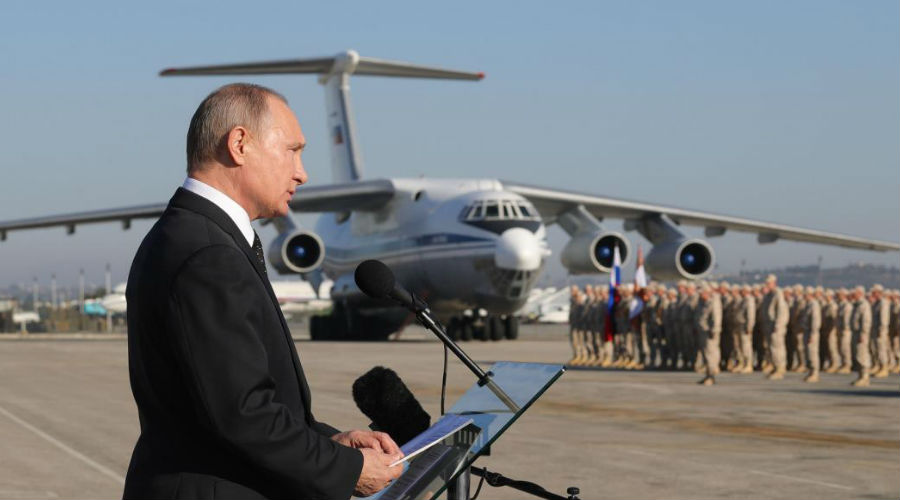Russia has recently beefed up its defenses in Hmeimim Air Base in Latakia, Syria, with Pantsir-S2 missile system. Russian military officials declared that the new air defense system aims to intercept attacks by drones, particularly after the airbase came, over the past months, under a flurry of attacks using such drones. However, there seems to be other factors that prompted Russia to deploy this system at the current stage, chiefly the new developments concerning the imminent battle for Idlib. Moscow believes that Idlib was used as launching pad for attacking Hmeimim repeatedly during the past period.
Significant Shift
Pantsir-S2 is the latest generation of the Pantsir system, the first was Pantsir-S1, which Syria acquired under an agreement concluded in 2008. Russia began supplying it in 2012 and which, according to Russian official reports, is credited with the interception of the Turkish F-4 Phantom jet over Syrian airspace in July of that year. However, this was not made public until April 2018, when the Syrian Ministry of Defense revealed that the army has up to 50 batteries with a total of 700 missiles amounting to $730 million.
Various estimates have raised numerous questions about the reasons for the presence of the two systems in Syria at such close intervals and have doubts about the ability of the Syrian regime to finance such huge deals at a time when it is under strong pressure from the military conflict that has entered its eighth year. But as a matter of fact, according to the Russian military, the regime does not seem to have acquired the new system, instead it has been transferred by Russia to its army base at Hmeimim to secure its defenses. Therefore, it is a matter of supplying a Russian-operated base in Syria and not supplying Syria itself with the system. This conclusion is corroborated by statements by the Deputy Commander of the Russian Air Defense Forces Yuriy Grekhov, who indicated that the system would be deployed in Syria to protect Russian Air Force forces at the Hmeimim base.
Multiple Objectives
It can be argued that Russia, by providing Hmeimim air base with this system, is striving to achieve numerous objectives, at the forefront of which are the following:
1- Building a multi-layered defence system: Russia has deployed all short, medium, and long-range defence systems in Syria. In addition to the Pantsir system, it has deployed the S-200, S-300 and S-400 systems.
Evidently, Russia was obliged to deploy these systems as part of its defensive plans. Initially, Russia was monitoring the international air traffic of the international coalition in Syria, particularly the US jet fighters, which required the deployment of long-range air defences. At a later stage, however, it deployed other systems with the emergence of a new threat from its opponents in Syria, such as terrorist organizations which resorted to the heavy use of drones against Russian targets, chiefly against Hmeimim base, at the beginning and the middle of this year.
According to Russian reports, the first attack, announced on 8 January 2018, led to the destruction of seven aircrafts on the ground and a weapon depot. Accusations were levelled at al-Nusra-Front factions. A similar attack occurred later in June of the same year. It seems that the new system was not in operation during that period, as these positions were covered by Pantsir-S1.
Thus, the new system aims to close the defense gaps in various short-ranges, with the new system covering a range of 30 to 40 kilometers, along with a SOTS S-band search radar to increase the detection range from 36 kilometers to more than 40 kilometers.
2- Readying for Idlib’s battle: Significantly, the announcement of transferring new Russian system to the Hmeimim base has coincided with threats made by Russia and the Syrian regime to launch an imminent military offensive against Idlib. Bearing in mind that most of drone attacks were launched from Rif Idlib, this means that the frequent use of drones to attack Russian bases in Latakia, especially by al-Nusra Front- which Russia accuses every time of standing behind the attacks on its bases- remains a strong possibility.
Despite efforts to bolster its defenses, Russia cannot rule out the possibility that its bases come under attacks by some factions that would engage in the battle, whether al-Nusra Front or even ISIS, which has already used drones extensively in both Iraq and Syria.
3- Military posturing: The marketing aspect of the Russian weapons used in Syria has been always present in the various Russian declarations on weapons that have recently entered the service in Syria, most notably was the announcement of the SU-57 aircraft, as well as air defence systems. Although the Pantsir-S2 system has been tried and tested in Donbass, Ukraine, where Russia provided the separatists with the system, deploying it in Syria remains particularly important, as evidenced by the Russian armament reports, which consider the experience in Syria to be an important one.
Moreover, Russia plans to deploy a fast-Armored Vehicle Land Bridge (AVLB) on the battlefield that is likely to erupt in Idlib in the coming period, which may only compete -in the Middle East - with Israel’s Iron Dome, which is used in the same ranges.
In conclusion, it can be argued that through this step, Moscow is seeking to close the gaps in its defenses which led to targeting its interests in Syria and increased military losses, and prepare early for the looming battle in Idlib, which will have significant repercussions on the trajectory of the Syrian conflict and the position of concerned regional and international powers, in the next period.


